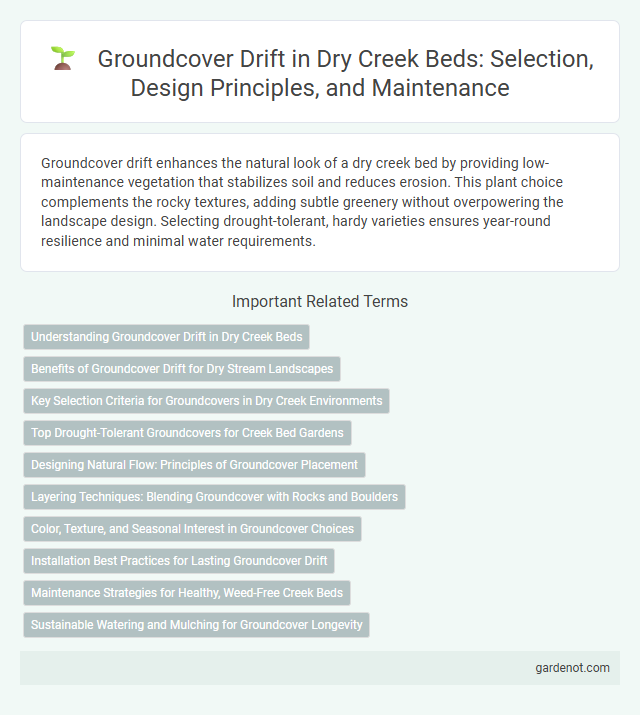Groundcover drift enhances the natural look of a dry creek bed by providing low-maintenance vegetation that stabilizes soil and reduces erosion. This plant choice complements the rocky textures, adding subtle greenery without overpowering the landscape design. Selecting drought-tolerant, hardy varieties ensures year-round resilience and minimal water requirements.
Understanding Groundcover Drift in Dry Creek Beds
Groundcover drift in dry creek beds refers to the natural or artificial movement of low-growing vegetation that helps stabilize soil and prevent erosion. Understanding how groundcover plants spread and interact with environmental factors like water flow and sunlight is essential for maintaining the ecological balance and aesthetic function of dry creek beds. Selecting species with strong root systems and adaptability to dry, rocky conditions optimizes groundcover drift, enhancing erosion control and habitat value.
Benefits of Groundcover Drift for Dry Stream Landscapes
Groundcover Drift enhances dry creek bed landscapes by stabilizing soil and preventing erosion through dense root systems that hold substrate in place. Its drought-tolerant nature ensures low water requirements, making it ideal for arid environments while maintaining visual appeal with consistent greenery and seasonal blooms. The dense foliage also suppresses weed growth, reducing maintenance needs and promoting a healthy, sustainable ecosystem in dry stream settings.
Key Selection Criteria for Groundcovers in Dry Creek Environments
Key selection criteria for groundcovers in dry creek environments include drought tolerance, root stability, and erosion control capabilities. Plants such as creeping thyme, sedum, and native grasses thrive in well-drained soils while preventing soil displacement during heavy flow events. Prioritizing species with low water requirements and deep root systems enhances sustainability and maintains the ecological balance of dry creek beds.
Top Drought-Tolerant Groundcovers for Creek Bed Gardens
Groundcovers like creeping thyme, sedum, and blue fescue offer excellent drought tolerance and thrive in dry creek bed gardens with minimal water requirements. These plants provide erosion control while adding texture and color to the rocky landscape, enhancing both functionality and aesthetics. Their deep root systems stabilize soil, preventing washouts during occasional rain, making them ideal for sustainable dry creek bed groundcover drift.
Designing Natural Flow: Principles of Groundcover Placement
Groundcover drift in dry creek bed design enhances natural flow by mimicking the organic patterns of water movement over time. Strategic placement prioritizes varying plant heights and textures to create a layered effect, guiding water and debris while preventing soil erosion. Using native, drought-tolerant species ensures sustainability and reinforces the ecological integrity of the landscape.
Layering Techniques: Blending Groundcover with Rocks and Boulders
Layering groundcover with rocks and boulders in a dry creek bed enhances natural aesthetics while optimizing erosion control and moisture retention. Selecting low-growing, drought-tolerant plants like creeping thyme, sedum, or creeping juniper creates a lush carpet that seamlessly integrates with stone textures and shapes. This technique supports soil stabilization, encourages biodiversity, and highlights the organic flow of the dry creek design.
Color, Texture, and Seasonal Interest in Groundcover Choices
Groundcover drift in a dry creek bed offers a vibrant palette of colors, ranging from deep greens to silvery grays and rich purples that enhance the natural landscape. Textural variety is achieved through low-growing plants like creeping thyme, sedum, and creeping juniper, providing a mix of smooth, fuzzy, and spiky foliage that contrasts with rocky elements. Seasonal interest is maintained as many groundcovers bloom in spring and summer, while their foliage shifts in color during fall, ensuring year-round visual appeal in dry creek beds.
Installation Best Practices for Lasting Groundcover Drift
Effective installation of groundcover drift requires thorough soil preparation to ensure proper drainage and root establishment. Use layered planting techniques, spacing plants according to their mature size to promote healthy growth and reduce maintenance. Mulching with organic material helps retain moisture, suppress weeds, and enhances the longevity of the groundcover in a dry creek bed environment.
Maintenance Strategies for Healthy, Weed-Free Creek Beds
Implementing a well-planned groundcover drift with drought-tolerant, native plants such as creeping thyme or sedum helps stabilize soil and suppress weed growth in dry creek beds. Regular monitoring and targeted spot weeding combined with mulching using inorganic materials like gravel or decomposed granite maintain moisture and reduce weed seed germination. Integrating drip irrigation systems ensures deep watering, promoting healthy root development essential for long-term vegetation establishment and creek bed resilience.
Sustainable Watering and Mulching for Groundcover Longevity
Groundcover drift in dry creek beds benefits from sustainable watering methods such as drip irrigation to minimize water use while maintaining soil moisture. Mulching with organic materials like wood chips or bark enhances moisture retention, reduces evaporation, and suppresses weed growth. These practices collectively promote groundcover longevity by creating a stable microenvironment conducive to healthy root systems and drought resilience.
Groundcover drift Infographic

 gardenot.com
gardenot.com